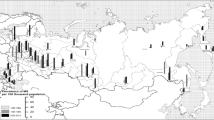Abstract
The USA is currently experiencing “jobless” economic growth, a situation which has been characteristic of European labour markets, and which has been coined “eurosclerosis”. This lack of employment growth in Europe has almost unanimously been ascribed to labour market institutions, although there has never been hard empirical support for this position. Now the US job machine does not seem to be working, although the American labour market institutions have not changed. Will we now see a decade of “US-sclerosis”?
Similar content being viewed by others
References
R. Freeman, R. Schettkat: Skill Compression, Wage Differentials and Employment. Germany versus the US, in: Oxford Economic Papers, 2001, pp. 582–603; A. Krueger, J. Pischke: Observations and Conjectures on the U.S. Employment Miracle, NBER Working Papers 6146, National Bureau of Economic Research, 1997; R. Schettkat: Institutional Rigidities at the Root of European Unemployment? The Rigidity Hypothesis evaluated by the Dutch and German Experiences, in: Cambridge Journal of Economics, Vol. 27, No. 6, 2003, pp. 771–787; R. Schettkat: Institutions in the Economic Fitness Landscape; What Impact do Welfare State Institutions have on Economic Performance?, in: CESifo DICE Report 2/2003.
Since the US population was also growing, income per capita grew much less in the USA. Cf. R. Schettkat: Demand Patterns and Employment Structures; an Aggregate Analysis, paper prepared for the DEMPATEM conference October 2003, Seville, Spain.
Measured in hours worked rather than persons employed the USA-Europe contrast is even stronger. Cf. R. Schettkat, op. cit. Demand Patterns and Employment Structures; an Aggregate Analysis, paper prepared for the DEMPATEM conference October 2003, Seville, Spain.
Two books use “roaring nineties” in their titles: A. Krueger, R. Solow: The Roaring Nineties: Can Full Employment Be Sustained?, New York 2001, Russell Sage; and J. Stiglitz: The Roaring Nineties, New York, London 2003, Norton & Company.
Cf. A. Krueger: Slippery Data on the Job Market, New York Times, September 18, 2003.
The identity problem is clear again: would Europe have achieved the same rates of economic growth with lower productivity growth? The causation seems to run both ways: higher rates of economic growth can result in higher productivity growth (Kaldor-Verdoorn relation) but continuous economic growth, for sure, requires productivity growth (cf. R. Solow: A Contribution to the Theory of Economic Growth, in: Quarterly Journal of Economics, Vol. 70, pp. 65–94). Economic development can best be understood as the interaction of both sides of the market, or dermand and supply, as in evolutionary growth theory.
Cf. R. Schettkat, op. cit. Demand Patterns and Employment Structures; an Aggregate Analysis, paper prepared for the DEMPATEM conference October 2003, Seville, Spain.
O. Issing: The Monetary Policy of the European Central Bank: Strategy and Implementation, in: CESifo Forum, No. 2, 2000.
A. Blinder, R. Solow: Does fiscal policy matter?, in: Journal of Public Economics, 1973, No. 2, pp. 329–337.
Cf. A. Blinder: Central banking in theory and practice, Cambridge, Mass. 1998, MIT Press.
US Bureau of Economic Analysis, webpages.
OECD Economic Outlook 2003: GDP price deflator.
J. Stiglitz, op. cit..
Ibid..
Cf. US Bureau of Economic Analysis, webpages.
J. E. Triplett, B. P. Bosworth: Productivity Measurement Issues in Services Industries: Baumol's Disease Has Been Cured, in: Economic Policy Review, September 2003, pp. 23–33, Federal Reserve Bank of New York.
H. R. Varian: Rising productivity is a good thing, right? Tell that to the newly unemployed, in: New York Times, October 23, 2003, C2.
Author information
Authors and Affiliations
Rights and permissions
About this article
Cite this article
Schettkat, R. US-sclerosis?. Intereconomics 39, 46–50 (2004). https://doi.org/10.1007/BF03032206
Issue Date:
DOI: https://doi.org/10.1007/BF03032206




